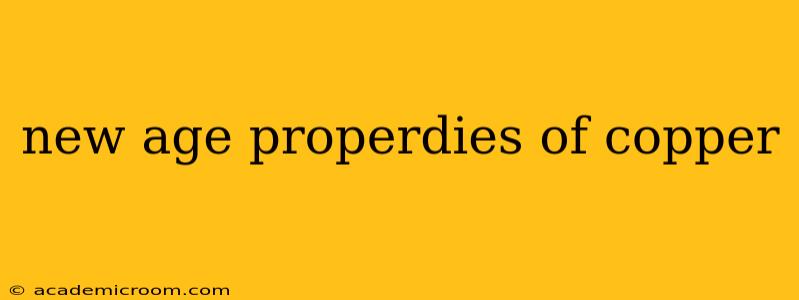Copper, a reddish-brown metal known for its conductivity and malleability, has been used by humans for millennia. However, beyond its traditional applications in electrical wiring and plumbing, copper is experiencing a renaissance, showcasing exciting "new age" properties that are driving innovation across various sectors. This exploration delves into these emerging applications, moving beyond the well-trodden path to reveal copper's surprising versatility.
What are the Unique Properties of Copper?
Copper's inherent qualities are at the heart of its expanding applications. Its exceptional electrical conductivity, second only to silver, remains a cornerstone of its use. Furthermore, its excellent thermal conductivity makes it ideal for heat transfer applications. But the "new age" properties we're focusing on extend beyond these fundamental characteristics. We'll be examining its antimicrobial capabilities, its role in sustainable technologies, and its growing presence in advanced materials.
Is Copper Antimicrobial?
Yes, copper possesses potent antimicrobial properties. This inherent ability to kill or inhibit the growth of microorganisms like bacteria and viruses is driving its use in healthcare settings and beyond. Copper surfaces have been shown to significantly reduce the presence of harmful pathogens, contributing to improved hygiene and infection control. This naturally occurring property makes copper a compelling alternative to chemically treated surfaces, offering a sustainable and effective solution.
What are the Sustainable Applications of Copper?
Copper plays a crucial role in the transition to a more sustainable future. Its excellent recyclability, coupled with its inherent durability, contributes to a circular economy. Moreover, copper's use in renewable energy technologies, such as solar panels and wind turbines, is expanding rapidly. Its high conductivity is essential for efficient energy transmission and distribution. This makes copper a vital component of a greener, more sustainable energy infrastructure.
How is Copper Used in Advanced Materials?
Copper's versatility extends to its incorporation into advanced materials. Nanotechnology, for example, is leveraging copper's unique properties to create novel materials with enhanced characteristics. Copper nanoparticles are being explored for applications ranging from targeted drug delivery to advanced electronics. The ability to manipulate copper at the nanoscale unlocks exciting possibilities for material science and engineering.
Why is Copper Important for the Future?
Copper's importance for the future stems from its unique combination of traditional strengths and emerging applications. Its proven reliability, coupled with its sustainability and antimicrobial properties, positions it as a key material for tackling global challenges. From combating infectious diseases to facilitating the transition to renewable energy, copper is emerging as a vital component of a more sustainable and technologically advanced future.
Frequently Asked Questions (FAQ)
Is Copper a Good Conductor of Heat?
Yes, copper is an exceptionally good conductor of heat, second only to silver. This makes it ideal for applications requiring efficient heat transfer, such as heat exchangers and cooking utensils.
What are the Environmental Benefits of Using Copper?
Copper's high recyclability and durability significantly reduce environmental impact compared to other materials. Its use in renewable energy technologies further contributes to a more sustainable future.
How is Copper Used in Healthcare?
Copper's antimicrobial properties are leading to its increased use in healthcare settings. Copper surfaces in hospitals and clinics can help reduce the spread of infections.
Is Copper Safe for Use in Food Contact Applications?
Yes, copper is generally considered safe for use in food contact applications, provided it conforms to relevant food safety standards. However, it's crucial to ensure proper hygiene and maintenance to prevent contamination.
What are the Future Applications of Copper Nanotechnology?
The future of copper nanotechnology is vast and exciting. Potential applications include advanced electronics, targeted drug delivery, and the development of new materials with superior properties.
This detailed exploration of copper's "new age" properties offers a comprehensive understanding of its expanding applications and its significant role in shaping a sustainable and technologically advanced future. Its inherent versatility continues to surprise and inspire innovation across a wide range of industries.
